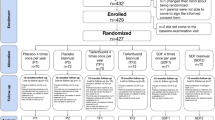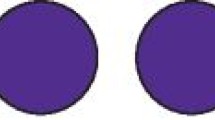Abstract
Design A 3-year randomised controlled trial in 180 13 to 14-year-old subjects.
Intervention Either 0.1% fluoride or 1% chlorhexidine/thymol varnish professionally applied after prophylaxis every 3 months.
Outcome measure Caries increment was identified using bitewing radiographs. The assessor was blind to treatment allocation.
Results There were no significant differences between the two groups, with about three new approximal surfaces per child decayed or filled in each group, mostly restricted to the enamel surface (see Table 1).
Conclusions There was no difference in caries experience with the use of fluoride varnish compared with the use of chlorhexidine varnish.
Similar content being viewed by others
Commentary
This Table 1 trial directly compares the anticaries effect of two varnish vehicles, one containing both 1.0% chlorhexidine and 1.0% thymol and the other containing 0.1% fluoride. The study was carefully designed and exhibits good internal validity.
No statistically significant difference was observed between the two treatments in the incidence of approximal dental caries rates over 3 years, as determined by bitewing radiographs. The effect size was 9% in favour of the fluoride varnish. The study, therefore, lacked the statistical power to detect a difference as small as this between the two treatments. The treatments should not be declared equivalent from the results of this study, however, because equivalence was not defined nor was the study designed to detect it.
The difference in effect observed between the two treatments should not be considered clinically significant. Based on these results, there is no strong justification for using a chlorhexidine varnish rather than a fluoride varnish for approximal caries prevention in teenagers. In fact, based on the cost of the products and the concern over the use of a potent topical antimicrobial without a specific indication, a fluoride varnish would be the treatment of choice.
When prescribing an anticaries procedure, the mouth is usually the unit of treatment rather than specific sites within the mouth. Although the findings of this study relate only to approximal dental caries, they could be generalised to caries in other sites and other age-groups. There is evidence to support a beneficial effect for both varnish vehicles on caries in other sites within the mouth and in other population subgroups.
Since a placebo group was not included in the study, the absolute efficacy of the chlorhexidine and fluoride varnishes cannot be determined. The 3-year mean incidence rate for both treatments was around 3.0, which is sufficiently high to question whether or not either treatment provided much preventive benefit against approximal dental caries. Although most of the new lesions were confined to the enamel, it would be imprudent to conclude from this study that the rate of progression of the lesions was altered.
Practice point
-
This study does not provide compelling evidence that a 1% chlorhexidine plus 1% thymol varnish offers any advantage over a 0.1% fluoride varnish for approximal dental caries prevention.
Author information
Authors and Affiliations
Additional information
Address for correspondence: LG Peterson, Department of Preventive Dentistry, Medical and Dental Health Centre, Länssjukhuset, S-30185 Halmstadt, Sweden. E-mail: lars.g.petersson@lthalland.se
Petersson LG, Magnusson K, Andersson H, Almquist B, Twetman S. Effect of quarterly treatments with a chlorhexidine and a fluoride varnish on approximal caries. Caries Res 2000; 34:140–143
Rights and permissions
About this article
Cite this article
Banting, D. No difference between topical chlorhexidine and fluoride varnishes in preventing caries?. Evid Based Dent 4, 12 (2003). https://doi.org/10.1038/sj.ebd.6400162
Published:
Issue Date:
DOI: https://doi.org/10.1038/sj.ebd.6400162



